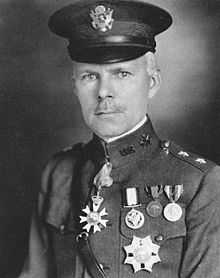George Owen Squier
| George Owen Squier | |
|---|---|
 Major General George Owen Squier | |
| Born |
March 21, 1865[1] Dryden, Michigan |
| Died |
March 24, 1934 (aged 69) Washington, D.C. |
| Buried at | Arlington National Cemetery |
| Allegiance |
|
| Service/branch |
|
| Years of service | 1887–1923 |
| Rank |
|
| Commands held | Chief Signal Officer |
| Battles/wars |
Spanish–American War World War I |
| Awards |
Distinguished Service Medal Honorary Knight Commander of the Order of St Michael and St George Order of the Crown of Italy Legion of Honor Elliott Cresson Medal John Scott Medal Franklin Medal |
| Other work | businessman, scientist |
Major General George Owen Squier (March 21, 1865 – March 24, 1934) was born in Dryden, Michigan, United States.[1] He graduated from the United States Military Academy in the Class of 1887 and received a Ph.D. from Johns Hopkins University in 1893.
Life and military career

George Squier wrote and edited many books and articles on the subject of radio and electricity. An inventor, he and Dartmouth professor Albert Cushing Crehore developed a magneto-optical streak camera "The Polarizing Photo-chronograph" in 1896 to measure the speed of projectiles both inside a cannon and directly after they left the cannon barrel. This was one of the earliest photonic programs. They also worked to develop synchronous AC telegraphic systems. His biggest contribution was that of telephone carrier multiplexing in 1910 for which he was elected to the National Academy of Science in 1919.
As executive officer to the Chief Signal Officer, U.S. Signal Corps in 1907, Squier was instrumental in the establishment of the Aeronautical Division, U.S. Signal Corps, the first organizational ancestor of the US Air Force. He also was the first military passenger in an airplane on September 12, 1908 and, working with the Wright Brothers, was responsible for the purchase of the first airplanes by the US Army in 1909.
From May 1916 to February 1917 he was Chief of the Aviation Section, U.S. Signal Corps, the first successor of the Aeronautical Division, before being promoted to major general and appointed Chief Signal Officer during World War I.
In 1922 he created Wired Radio, a service which piped music to businesses and subscribers over wires. Liking how 'Kodak' was a made up name, in 1934, he decided later to change the service's name to 'Muzak'.
Asked how to say his name, he told The Literary Digest it was pronounced like the word square.[2]
He died in March 1934 of pneumonia.
Legacy
In 1943, the U.S. Navy named troopship USS General G. O. Squier (AP-130) in his honor. It was the lead ship of its class, which was known as General G. O. Squier class of transport ships.
General Squier Park, a historic district and waterpark in his hometown of Dryden, Michigan, is named in his honor.[3][4]
Publications
- Crehore, Albert Cushing; George Owen Squier (1897). The Polarizing Photo-Chronograph. London: John Wiley & Sons.
- — (1908). "The Present Status of Military Aeronautics". Annual Report of the Board of Regents of the Smithsonian Institution: 117. Retrieved 2009-08-07.
- — (1919). Multiplex Telephony And Telegraphy By Means Of Electric Waves Guided By Wires. Washington: Government Printing Office.
References
- ↑ 1.0 1.1 "Biographical Memoir of George Owen Squier 1865-1934", by Arthur E. Kennelly, National Academy of Sciences of the United States of America, Biographical Memoirs Volume XX, presented to the Academy at the Annual Meeting, 1938. Retrieved Apr 1, 2010.
- ↑ Funk, Charles Earle (1936). What's the name, please? A guide to the correct pronunciation of current prominent names. New York: Funk & Wagnalls. OCLC 1463642.
- ↑ http://www.lapeercountyweb.org/parks.htm
- ↑ http://www.mcgi.state.mi.us/hso/sites/8355.htm
External links
- George O. Squier (Cullum's Register entry)
- Smithsonian West Point: George Squier
- National Academy of Science
- United States Army Signal Center
|